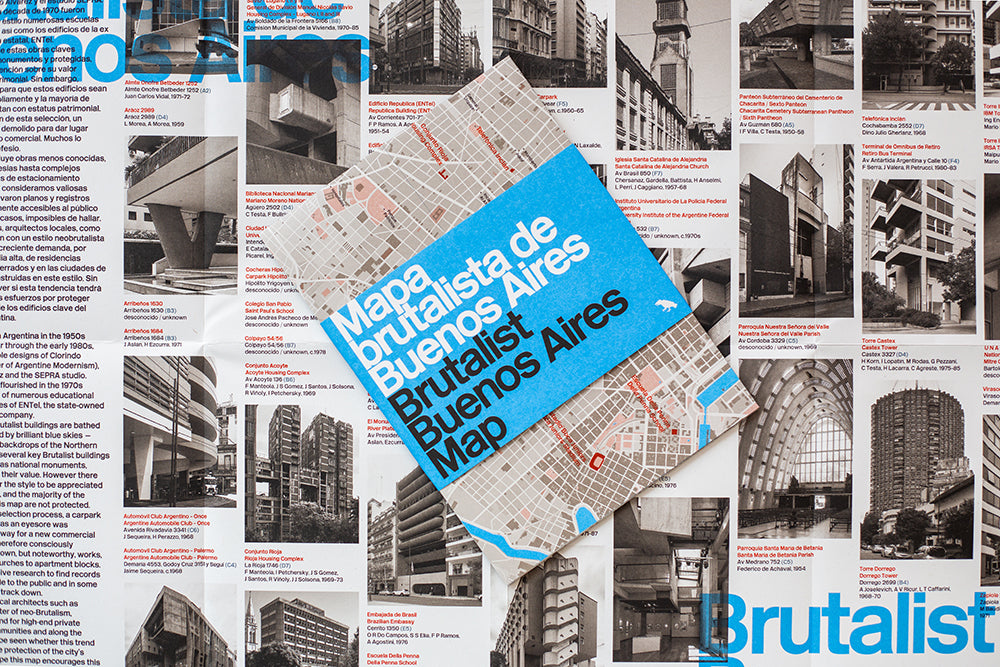
Discovering Brutalist architecture in Buenos Aires with Vanessa Bell
Share
Here we meet Vanessa Bell, Anglo-Argentine, Buenos Aires-based writer, curator, educator and author of our new Brutalist Buenos Aires Map. Here she tells us how she became interested in Brutalism, reveals some insight into her research process, and offers a little afternoon itinerary complete with some local coffee, food and wine spots.
What’s your experience of living in Buenos Aires? What do you like about the city?
Buenos Aires is a city in constant flux and change. In the pandemic there was a huge gastronomic explosion and it seems like each week there is a new opening to check out. It’s also a city which conceals a lot of its magic down tucked away alleyways and behind closed doors which is a dream for me as I’m so curious.
What interests you personally in Brutalism as a movement, and Brutalism in Buenos Aires specifically?
I went to uni in London and enjoyed the South Bank, The Hayward Gallery, and the Barbican. Far from depressing me with the constant grey London skies, these buildings always inspired me from a design perspective, but I don’t think I really realised how much I enjoyed this type of architecture until I became a design and architecture journalist and began to photograph architecture in Buenos Aires. My interest in brutalism flourished. In Buenos Aires there weren’t the same socio-political associations as in Eastern Europe or the UK for example and many projects worked with impressive budgets, and with the sunny climate and brilliant blue backdrops the buildings look more beautiful.
Which buildings on the map were listed as protected monuments in 2017? Can you give any short descriptive details on each building and what makes it special?
The ENTel building, SOMISA and the Biblioteca Nacional were all protected in 2017. The Banco de Londres had previously been given protected status in 1999.
The three buildings challenged architectural conventions at the time and are outstanding examples of the genre.

Can you pick a lesser known architect who has been featured on the map and tell us some information about them, and which building or buildings they designed?
I like the two ACA (Argentine Automobile Club) car parks I selected for the map built in the 60s and designed by Jaime Sequeira - I don’t know anything about him but I always like to say when I’m passing the Once branch that it’s like a small scale local take on The Guggenheim.
Are there any female architects listed? If so – who are they and which buildings did they design?
Yes, Ítala Fulvia Villa designed the Chacarita Cemetery Pantheon but for many years was overshadowed by the participation of Clorindo Testa in the project. It’s good that she’s being recognised as the main author of the work as for many years it was solely credited to Testa.

We’re very interested in the research you did digging in municipal records and discovering plans – can you tell us the story behind the most epic discovery you made?
I picked the brains of friends who are architects, acquaintances who work in the department of Patrimonio at city and national level. I was given leads by my followers on IG and Twitter who happened to live in some of the residential buildings I shared in stories – these messages were often encouraging and gave me the impression that they liked living there. I was then able to verify the information via other sources. I looked through 70s archival copies of SUMMA, a seminal architecture magazine and used the online library of SCA, The Central Society of Architects. Many of the buildings we’ve featured in the map have never been listed outside of local architecture publications.

We set aside an afternoon to explore the city with your map – please can you craft a short itinerary for the reader?
I would start at the Bank of London, one of Clorindo Testa’s most impressive works, which is the heart of the banking district downtown and is nice to see on a Saturday when it’s quiet. I would suggest walking around the centre, taking in the historic buildings and wide avenues of the centre, the Plaza de Mayo, the Cathedral, maybe venturing into San Telmo. The only building by Mario Botta is located closeby, for those who like ostmodernism, originally built for the Italian Banca Nazionale del Lavoro in 1989, it now operates as a branch of HSBC. Nearby is the SOMISA building and opposite is Alfonso, a nice little bistro to enjoy a glass of wine or a quick bite to eat @alfonso.cocinanomade on IG en route. From there head to the Brazilian Embassy, taking in the art deco and rationalist theatres the Opera and Grand Rex on Corrientes Avenue and then turn onto the 9 de Julio Avenue and the plethora of eclectic buildings and styles along the way. For good coffee head to Shelter Coffee or tucked away Kissaten Tostador, Arroyo Street, or for something traditional and quintessentially Porteno, head in the opposite direction and grab the best sandwich de lomo (fillet steak) sandwich in town at La Rambla. Remember to order with fries and an ice cold Quilmes.
The Shelter Coffee - Arroyo 940
Kissaten Tostador - Arroyo 826, piso 1 (first floor)
La Rambla - Posadas 1602
Brutalist Buenos Aires Map is available here.
